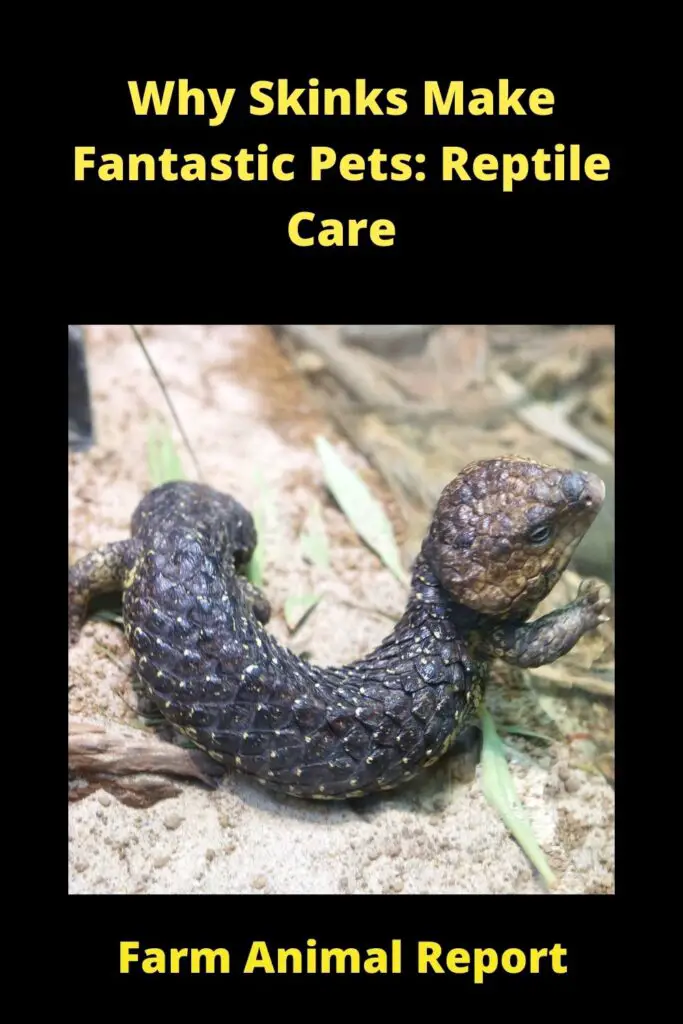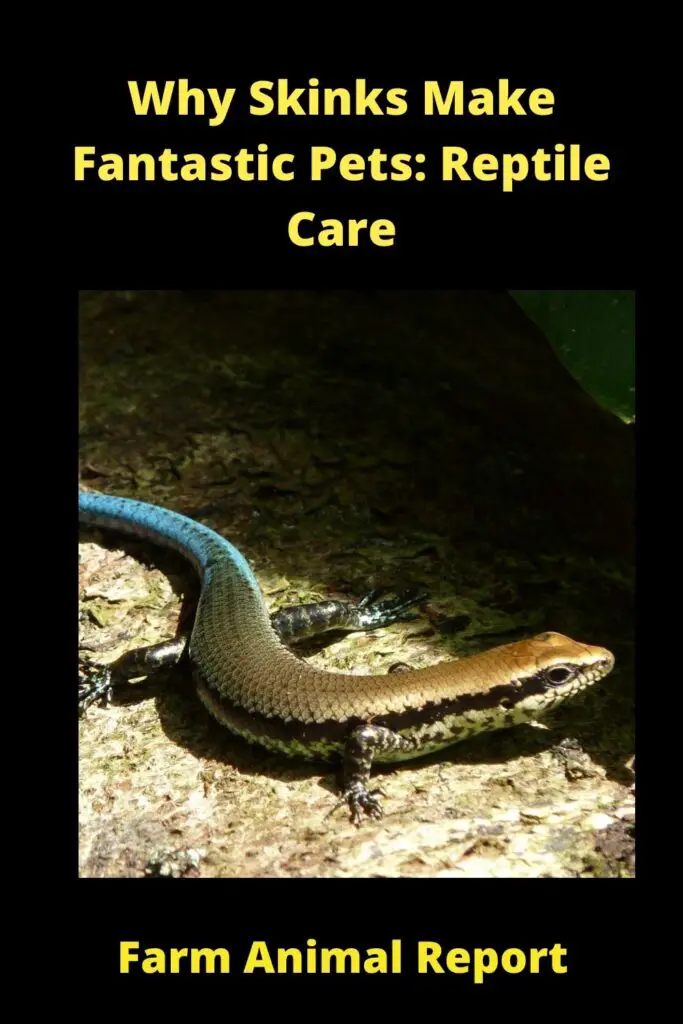Pet Skinks: Reptile Care
Skinks are the ideal pet for people who don’t have a lot of space or time to spend with their pets. They are relatively easy to care for, and can be handled by kids as young as 8 years old! Skinks make fantastic pets because they require little work, take up very little room in your home, and provide hours of entertainment for you and your family.
Species Summary
There are over 2000 different species of skink. Skinks have a wide variety of habitats and can be found in forests, coastal regions, deserts, and grasslands all around the world. There is a huge amount of diversity within this family – some skinks live on trees or rocks while others burrow underground!
Skinks make fantastic pets because they require little work, take up very little room in your home, and provide hours of entertainment for you and your family.

Skink appearance and Colors
Skinks are small lizards that range in size from a few inches to over two feet long. They have shiny, smooth skin and strong legs with sharp claws for climbing. Depending on what species of skink they are, skinks can be green or brownish-grey, black or white/yellow – even blue! Skinks come in a wide variety of colors, and this makes them extremely fun to look at.
Skinks can be green or brownish-grey, black or white/yellow – even blue! Skinks come in a wide variety of colors, and this makes them extremely fun to look at.
Skink Lifespans and litter Sizes
Skinks can live as long as 20 years, but some species of skink only live for a few years. Skinks have litters that range from one to over 30 babies at a time! This makes it very easy and inexpensive to own multiple pet skinks – they don’t take up much space and they all eat the same food, so you don’t have to buy multiple diets.
Skink Average Size and weight
It is extremely easy to find a pet skink that fits your home and lifestyle. They can be as small as two inches or over a foot long! It all depends on what species it is, so be sure to research if you have any space restrictions at home. Skinks average around one pound in weight – again, this depends on the species.
Skink Care Consist of
Skink care is easy and inexpensive! Skinks eat insects, so you will need to feed them crickets or mealworms. Make sure the crickets are gut-loaded before feeding them to your pet skink – this means they have been fed nutritious food for at least 24 hours before being given as a meal to your lizard. You can purchase insect care products from your local pet store. Skinks also require a variety of different surfaces to climb on – rocks, branches, and logs are great for skink habitat decoration! You can find all of these items at your local pet or reptile supply stores.
Skink Enclosure Size
The Average size enclosure for a pet skink is about one square foot. You can purchase or build your own enclosure – all you need to do is make sure the lizard cannot escape! Skinks are very good climbers, so it’s important that their habitat has plenty of branches and logs they can climb on to keep them happy.
Screens cages are the best type of home for pet skinks. They allow fresh air to circulate through your lizard’s enclosure, and they also provide a huge surface area for climbing! Make sure you get at least two different types of substrate (surface material) – one that can hold humidity like cypress mulch or eco earth mixed with sphagnum moss, the other needs to be firm like aspen wood shavings. Make sure you have at least two hiding places for your skink – one on the cool side of his enclosure and another on the warm side.

Items Needed for Setting Up the Habitat
There are a few items you need to make sure your skink has in his habitat. You will want at least two different types of substrate (surface material) – one that can hold humidity like cypress mulch or eco earth mixed with sphagnum moss, the other needs to be firm like aspen wood shavings. Make sure you have at least two hiding places for your skink – one on the cool side of his enclosure and another on the warm side. You will also want a variety of branches, logs or rocks to provide climbing opportunities inside of their habitat. Finally, make sure that once per week you clean out all waste from under where they sleep (this is called the ‘cool side of the enclosure’) and all feces from where they eat (this is called their ‘warm side’).
Skink Temperature and Lighting Needs
Skinks are nocturnal, so you will need to make sure their habitat has a light that simulates night. Make sure this is on for about 12 hours every day – skinks do most of their activity at night! You want the temperature on the cool side to be 80-85 degrees Fahrenheit and the warm end should stay around 90-95 degrees Fahrenheit. Make sure you check the temperature with a thermometer first before buying an infrared or heat lamp, as skinks cannot handle direct sunlight at all!
The average size enclosure for a pet skink is about one square foot. You can purchase or build your own enclosure – all you need to do is make sure the lizard cannot escape! Skinks are very good climbers, so it’s important that their habitat has plenty of branches and logs they can climb on.
Types of Lights you can buy are
You can purchase a variety of different types of lights for your skink. You need to make sure you get an infrared or heat bulb, as they cannot handle direct sunlight at all! Make sure it’s on from about 12 pm until about 12 am every day! During the night time, you will also want a light that simulates moonlight.
Humidity
You need to keep the humidity for your skink between 50% and 60%. You can tell the humidity level is correct if you put a few droplets of water on top of their habitat – it should look like they are about to burst. If there’s too much moisture in the air, make sure you have more ventilation!
Skinks drink water by lapping it from small dishes, so make sure you have a couple of dishes of water in their habitat at all times. Never place the bowls on top of branches or rocks – always put them on the substrate!

Skinks need Water
Both male and female skinks need to have water available in their habitat at all times. Make sure the bowls of water are on a firm surface, not on top of branches or rocks! Skinks will drink from droplets that form off these dishes when they get too moist, so it’s important you keep them filled with fresh clean drinking water!
Skinks will need a lot of food – you can feed them either small insects or fruit and vegetables. Make sure to dust every insect with calcium powder before feeding it to your skink, as they cannot digest bones very well on their own! For the most part, adult skinks should be fed once per day while juveniles have two feedings per day.
Skink Food is not “Dust”
Make sure you dust all of your skink’s food with calcium powder before feeding it to him. This will keep their bones strong and healthy, as they cannot digest high amounts of bone on their own! Most adult skinks can be fed once per day while juveniles need two feedings a day.
Skink Common Health Problems
Skinks can lead long and happy lives as pets. Like most animals, however, they are susceptible to a host of health issues. A few common reasons why skink owners seek pet care advice from vets include:
– Ingestion of substrates such as gravel or sand
– Overgrown nails that need clipping
– Failure to thrive
– Mites
– Parasite infestation (which can lead to Metabolic Bone Disease)
You may notice that many of these reasons are related to skink habitat. Be sure to provide your pet with the best possible enclosure in order for him/her to remain happy and healthy long-term!
Skink Behavior and Temperament
Skink Behavior and Temperament Skink behavior varies from species to species, just as with any animal. Some are docile while others are more energetic or feisty. A few common traits that all of these lizards share include:
– They’re usually shy, so they don’t handle stress well.
– Skinks are territorial by nature and can be very defensive if threatened or startled.
– They typically like to burrow into the substrate of their enclosure in order to feel safe. Owners should provide them with plenty of hiding places for this purpose! If you have any other concerns about skink behavior, be sure to mention it to your vet.
Individually they can be
– Docile
– Energetic or feisty
– Shy and stressed easily

How to Handle a skink:
One of the reasons skinks make fantastic pets is that they are very docile. They rarely try to bite, and will instead use their tail as a defense mechanism. When you do handle your pet, be gentle but firm with them so they know who’s in control. You don’t want to scare or hurt them because this can lead to a lot of stress for your pet.
Final Thoughts:
If you’re looking for easy-care for a pet, then skinks might be the right choice. They are gentle and rarely bite; however, they may drop their tail as a defense mechanism when scared or threatened. So handle them with care!


